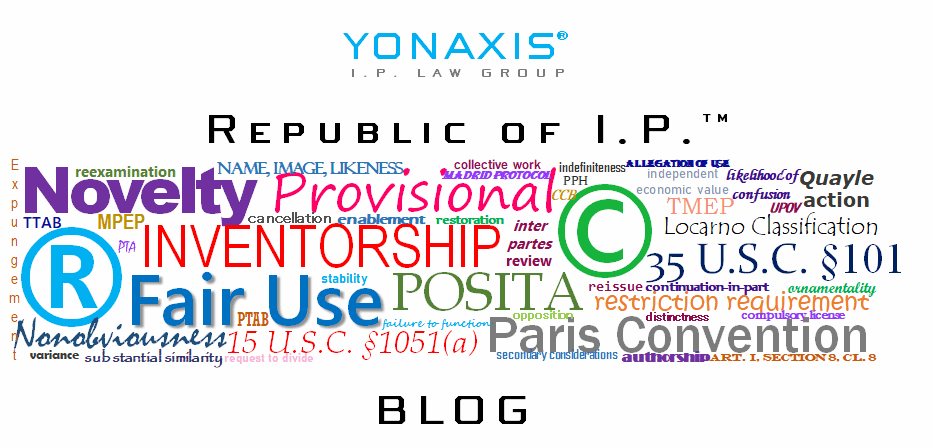Today is an auspicious day for cannabis proponents, so we illustrate one recently issued patent to recognize this date. U.S. Patent No. PP34,051 P3 (‘051) issued on March 22, 2022, for “Cannabis Plant Named ‘AV1-1.’” It was issued to inventor Ytzchak Cohen of Tel Aviv, Israel. The applicant/assignee is Tikun Olam Ltd. of Tel Aviv, …
Dark Horse No Joyful Noise to Ears of 9th Circuit
On March 10, 2022, the Court of Appeals for the Ninth Circuit held in Gray v. Hudson,[1] that an eight-note ostinato allegedly copied by defendants lacked originality to warrant copyright protection, affirming a district court ruling. Plaintiffs Marcus Gray (aka Flame), Emanuel Lambert, and Chilke Ojukwu form the three-member Christian hip-hop group known as Joyful …
No April Fool’s: Russia Allowing I.P. Theft in Wake of Ukraine War
The Russia-Ukraine war has just entered its second month, and it appears Russia is using intellectual property piracy as a weapon in retaliation for crippling economic sanctions levied against it after Russian forces invaded Ukraine in February 2022. The decree was issued on March 7, 2022, just two weeks after the Russian invasion. The decree …
More Russian Warships, More Failures to Function
As of March 21, 2022, the Russian invasion of Ukraine continues, and so do the filings of trademark applications capitalizing on that war. As discussed in an earlier blog, RUSSIAN WARSHIP, GO FUCK YOURSELF was filed on February 26, 2022, just two days after Russia invaded Ukraine. Since then, there have been six other renditions …
USPTO Cuts Ties with Rospatent, Belarus, EAPO
On March 7, 2022, the United States Patent and Trademark Office (USPTO) announced that it severed its ties with the Federal Service for Intellectual Property of Russia (i.e., Rospatent) and the Eurasian Patent Organization (EAPO) (which is based on Russia), as well as the National Center for Intellectual Property of Belarus. This is consistent with …
“Russian Warship, Go Fuck Yourself” as a Battle Cry? Yes. As a Registrable Mark? Probably Not
The world is currently seeing the invasion of Ukraine by Russia, and there has been one catchphrase which has seemingly captured the fighting ethos of the Ukrainian people: “Russian warship, go fuck yourself.” With that said, it was only a matter of time before this common phrase would wind its way as a trademark application …
Ukrpatent Is, Amazingly, Still Operating
As news of the Russian invasion of Ukraine happened last week, the Ukraine State Intellectual Property Institute, or Ukrpatent, announced that it is, in fact, still operating on full-time “providing all the necessary functions and continuous operation of the state system of legal protection of intellectual property.” The Ukrpatent office is located in downtown Kyiv, …
In U.S., Only Humans Can Be Inventors or Creators
In the U.S., patents are issued to inventors and copyrights are registered to authors. Artificial intelligence (AI) has been gaining traction in automation of business processes, creating more efficient applications, and gathering of data analysis. However, as seen with the recent U.S. Copyright Office’s recent Copyright Review Board’s (CRB) decision demonstrates that under U.S. copyright …
That Sucks! Otherwise Generic gTLD Still Non-Registrable Because Not Attached with Preceding Domain Name
On February 2, 2022, the Court of Appeals for the Federal Circuit affirmed in In re Vox Populi Registry Ltd.,[1] the decision of the USPTO’s Trademark Trial and Appeal Board (TTAB) refusing registration to .SUCKS as a service mark for Vox’s domain name registry services. However, the Fed Circuit agreed with the TTAB in that …
New Public Page for Trademark Non-Use Petitions
On February 4, 2022, the United States Patent and Trademark Office released a new public page showing new ex parte expungement or reexamination petitions for failure to use the challenged mark in commerce. Since its implementation on December 21, 2021, there have been 20 petitions for expungement and 10 petitions for reexamination filed on non-used …
